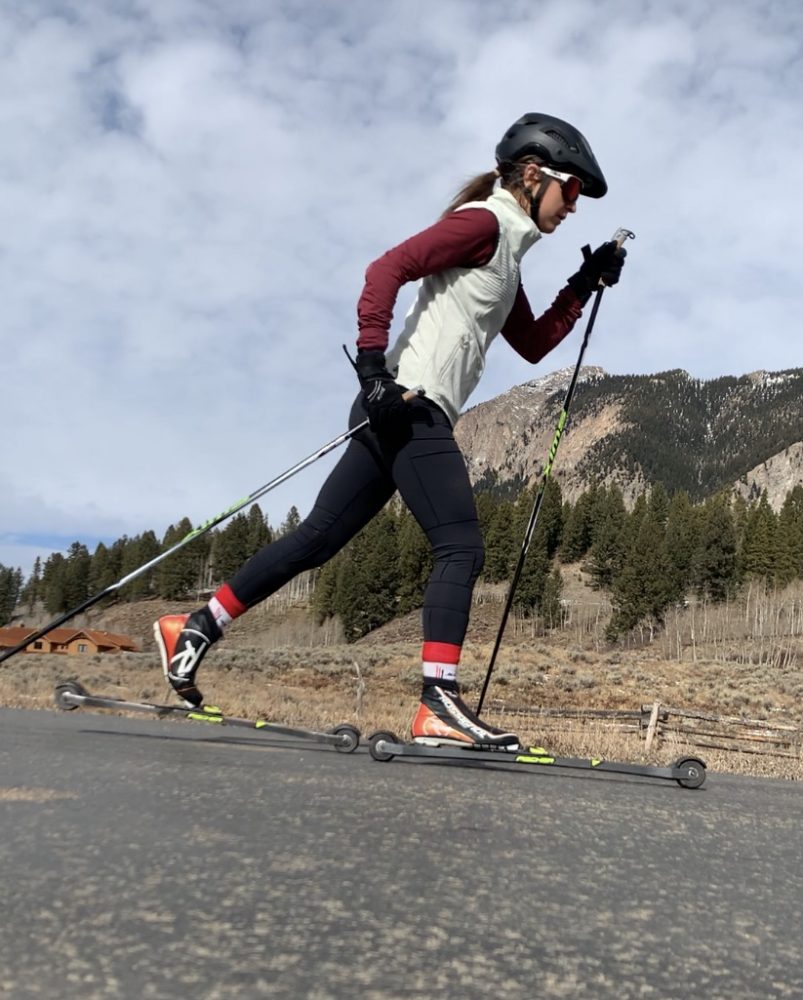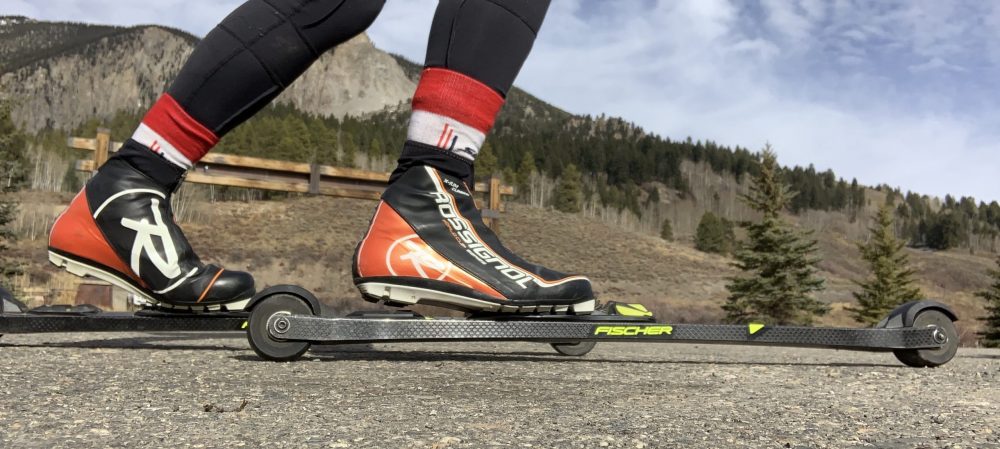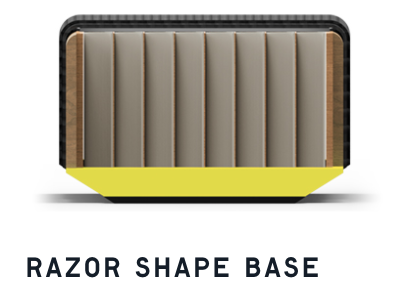Depending on where you live, rollerskis may seem like a distant memory, retired to a storage closet not to be looked at again until next May. For others, sliding on snow might not be the agenda for another month. Perhaps you are foregoing Thanksgiving travel to snow this year due to the pandemic, or you are an urban-dwelling weekend warrior whose usual routine of traveling regularly to snow has come to a halt.
Regardless of the circumstances, here’s a review of Fischer’s latest lineup of top-end rollerskis that make hitting the pavement enjoyable and feel realistic enough to keep you in love with the sport until your next chance to slide on snow.
Fischer Speedmax Classic Rollerski

Launched this season, the Speedmax Classic rollerski holds bragging rights as the lightest classic rollerski available. With a full carbon frame, the medium flex ski weighs just 830 g, roughly 20% less than the RC7 classic model. Two models are available: medium for skiers less than 85 kg, and stiff for those greater than 80 kg. The stiff frame adds just 20 additional grams.
Let’s put it simply: it’s noteworthy. The return of the ski when swinging back through felt much more like a classic ski and less like a clunky rollerski. Despite the ratcheted wheel, this might be the factor most attributable to the realistic feel of rollerskiing on the Speedmax.

The Speedmax features an arched construction shaft, mimicking the camber of a classic ski. A quick materials engineering lesson: while the frame is certainly stiff and rigid, a carbon weave is strongest when loaded axially, like the way you apply force along the shaft of your set of carbon ski poles. It also resists twisting, but we’ll get to that later.
When the rollerski is kicked, the load is applied perpendicular to the axis, meaning there is more forgiveness, giving a more realistic feeling of compressing a wax pocket. Though I’m about 25 kg below the threshold at which switching to the stiff shaft is advised, I had no trouble experiencing a realistic flex with the ski. I also noticed a significant amount of vibration dampening, making it comfortable — even for long sessions — to ski chip-seal or rough pavement.
The pair was also loaned to the top local junior, Kate Oldham, in the midst of her high volume summer training to join the Middlebury Ski Team this fall. Oldham noted a similar experience with the flex as one of the most remarkable features of the ski, expressing that it was more realistic than her aluminum Swix C1 pair she typically trained on. (Swix now sells a carbon fiber classic ski that FasterSkier has not yet reviewed.) Oldham also expressed that the resistance in the wheels provided a more realistic feel in terms of the glide from each push off and the control on downhills.
In addition to the lightness and realistic feel of the full carbon frame, the shaft provides torsional stability, keeping the ski balanced even when taking corners with speed. The 745 mm shaft is a few centimeters longer than other Fischer models and the 70 mm (45 mm width) wheels are smaller in diameter and wider than average. I felt this combo made it easier to drive the ski and glide straight more easily than other classic sets I’ve tried. The Speedmax tracking felt very balanced, smooth, and controlled, very similar to skiing outside the track on a groomed track.

And now for the downsides: given the full carbon construction, it is likely that the shaft does not provide the same durability you might expect from a composite or metal shaft. The arched shaft does improve ground clearance when unweighted, which helps protect the shaft when rolling over uneven surfaces, like getting on and off the wooden pedestrian bridges I regularly encounter. As carbon fiber is brittle, it is unclear how these would fare for full time high volume use season to season. I was lucky not to take any bad crashes while putting them to use, and Oldham opted not to use them for agility sessions during her testing out of concern for fragility. Bailing onto the rocky shoulder on a downhill or bad encounter with a curb could be devastating — I did my best not to find out the hard way. Ultimately, it’s the same cost-benefit analysis with any other piece of carbon fiber sporting equipment. We’ll leave it to you to run your own numbers.

The Speedmax classic rollerski retails at $379.00 and can be found
Want to see more? Here’s a video from Fischer.
Fischer Carbonlite Skate Rollerski

The 2020 Carbonlite Skate rollerski was a pleasure to test out. Fischer boasts that the Air Core Composite frame provides “excellent vibration dampening for smooth, efficient performance that feels just like real snow.” A new set of wheels definitely added fun and reward to what I normally see as a somewhat boring but necessary form of training to balance out the impact of summer running volume and keep my body feeling ready for ski season.
Near my home in Carbondale, CO, I have three standard rollerski options. One is a very smooth bike path, though I have to roll over ~1k of rough pavement and a raised wooden bridge to get there. One is a up-and-down 5k loop through a chip-sealed neighborhood with two bridge crossings that have gaps in the pavement at the entrance and exit and can be spicy if taken with speed. And one is a less-smooth bike path along ranches and the Crystal River with swooping curves that sometimes accumulate sand, gravel, and other debris from the ranch vehicles crossing at various points to access gates.

The Carbonlite Skate made all of these venues more enjoyable to ski. The 630 mm wheelbase allows for great handling, whether that be a quick reaction to dodge a patch of gravel or taking a corner at high speed during an interval. The length of the shaft also allows for a bit more flexion than I was accustomed, giving a more realistic push off.

Adding to the agility and maneuverability of the shaft is the “Razor Shaped Base”. Cross-sectionally, the bottom edges of the shaft are beveled, ensuring adequate ground clearance even with a steep kick angle and reducing the wear and tear on the ski.
In addition to commenting that the flex provided a realistic feel, Oldham noted the clearance as a feature she appreciated on the Carbonlites.
“I enjoyed the height of the skate skis. The bolts never scraped the ground while turning and I never bottomed out while going over bumps.”
I’m not sure I’d go quite as far as “just like real snow”, but putting it generously, I’d say it comes close to being on par with ideal spring conditions where the trail base is softening from its bulletproof overnight freeze to the buttery, fast, and firm surface we all know and love. Fast, smooth, probably still some exciting encounters of the “late seasons hazards may exist” nature. After all, that’s skiing on varied pavement.
The Carbonlite Skate rollerski also retails at $379.00.

If you’re looking for a high end rollerski to support your training year round, both of Fischer’s 2020 releases are a worthy choice.
Rachel Perkins
Rachel is an endurance sport enthusiast based in the Roaring Fork Valley of Colorado. You can find her cruising around on skinny skis, running in the mountains with her pup, or chasing her toddler (born Oct. 2018). Instagram: @bachrunner4646



